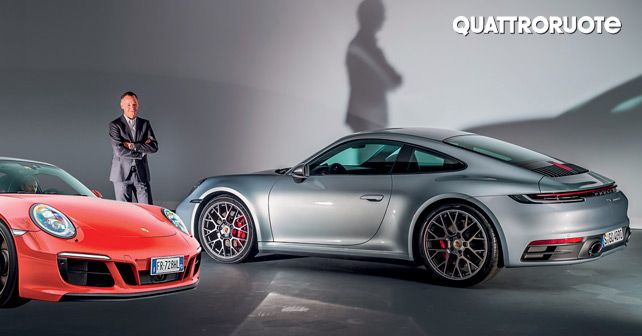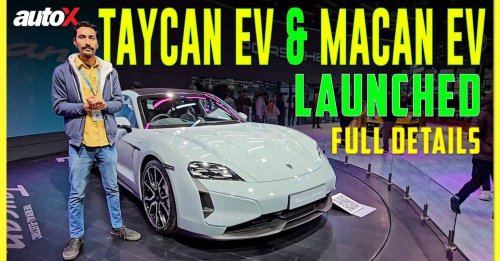
We drove a 991 GTS to Stuttgart to meet its heir, the 992 – which is more powerful, faster, better looking and soon-to-be-available as a hybrid as well.
The model codes at Porsche can be quite confusing – numeric formulas that follow a progression of their own. Sometimes they’re so confusing that they appear to have come from the mind of a crazy mathematician – something that none of us have ever been able to understand.
Nonetheless, my photographer and I found ourselves on board a 991 – there’s no need to explain that to enthusiasts in the know, but it’s the current generation 911 for those who don’t know – heading to meet its heir, the 992. In this case, we must admit, that the progression makes sense. Before the 991, however, there was the 997, which in turn was preceded by the 996, 993, 964 and 930. Interesting, isn’t it? But none of that matters, because we were driving a Porsche par excellence, and the only numbers that we were interested were those of the 0 to 100km/h acceleration time (4.1 seconds) and the top speed as reflected on the speedo (312km/h).
We were fully equipped – as best we could be, for we were driving the GTS version of the 991 with 450bhp – so as to not lose face in front of the latest model. We were heading to meet August Achleitner in Stuttgart. For those who don’t know him, he’s the man who designed the last three generations of this legend on wheels, so-much-so that he’s been named ‘Mister 911.’
But let’s not get ahead of ourselves, Stuttgart is still far away. In fact, between speed limits and long queues, we’re struggling to keep the GTS in check – especially when faced with smooth stretches of tarmac that tempt you to unleash this rear-engined beast. I was forced to put it in ‘Drive’ and enjoy the everyday usability of the 911. Frankly, the 911 makes for a great touring machine, with very little tyre and wind noise.
When we finally did make it to Stuttgart, Achleitner, while talking about the 992, said, ‘We’ve improved the soundproofing. And thanks to a more rigid structure that transmits fewer vibrations, we’re able to diminish the sounds we don’t want and highlight the ones we do – such as the sound of the boxer engine.’
And what an engine it is. The 992, in its S version, for the very first time, transcends the 4-second threshold for the 0 to 100km/h sprint – it now takes only 3.7 seconds to race to the tonne, which makes it almost half a second faster than the 991. And the 4S version of the 992 takes only 3.6 seconds, thanks to its all-wheel drive system.
GTS Performance for ‘S’ Pricing
And if you opt for the Sport Chrono package, you’ll gain an extra two extra tenths. In short, for the price of an S version, you get a car that offers more performance than the current generation GTS. Speaking of which, after crossing into Germany, we were finally able to open up the 991 on the unrestricted stretches of the Autobahn.
But it’s not just top speed and acceleration numbers that are important, if anything, it’s the sheer balance of the chassis and the high levels of confidence that the 911 instils in the driver. And this is something that we got to experience first-hand on the winding country roads after leaving the Autobahn, as we got close to Stuttgart. But this inherent balance that we experienced wasn’t enough for the engineers at Porsche. ‘In order to meet the goal of further refining its dynamic behaviour, we wanted to start from the fundamentals, without resorting to electronics. Therefore, we decided to widen the front track, allowing us to use a less rigid stabiliser bar,’ says Achleitner. ‘The combination of these elements has improved traction, especially while exiting a corner. We widened the rear track as well’ – which has led to those voluptuous rear haunches.
Now, you also have the option of choosing between the standard and Sport chassis, which is stiffer and offers yet more performance. But Mister 911 assures us that this does not compromise comfort – especially if you opt for the electronically controlled shock-absorbers – which became available for the first time on the 991. The electronics have also been designed to help the driver in the rain, with acoustic sensors that work on the variation of the sound frequency within the wheel wells. In case of water accumulation on the road, the system informs the driver of the risk of aquaplaning, while the control system, acting on the same signals, automatically adjusts the stability control. Now the driver, at his discretion, is free to apply additional measures. For instance, he can modify the behaviour of the self-locking differential by activating the ‘Wet’ mode.
Securing the 911’s future
Let’s now talk about the engine, which remains a 3.0-litre, flat-six, twin-turbocharged engine. Achleitner’s team, however, have worked rigorously on its evolution – and the results are apparent. In terms of consumption, Achleitner says they’ve achieved efficiency gains of between 3 to 5%.
Transmitting power to the wheels is a new 8-speed PDK (dual-clutch) gearbox, which proves pivotal in these stunning acceleration times. ‘Between the transmission and differential, we’ve left an empty space for the installation of an electric motor in future,’ explained the designer, while announcing that the launch of a hybrid version is not expected before 2022. ‘The reason,’ claims Achleitner, ‘is that there’s still a lot to do. We’re not satisfied with the combination of power, electric range and the additional weight of the battery.’
In order to reduce the weight of the vehicle, the body has undergone several modifications. For instance, the fenders, which previously were steel, are now aluminium. But the big wheels, the wider track, stiffer body, additional welding, and the particulate filter system don’t allow for a significant decrease in weight when compared to the 991. According to Achleitner, ‘These are compromises that are mandated by electrification.
“Compromise” is not an encouraging word for those who design sports cars, but here the very survival of the 991 was at stake, and we had to save it.’
Rendezvous
We need just the slightest excuse to drive a 911 across Europe. In this case, our mission was to pilot a 991-generation 911 from Italy to Germany to delve deeper into the brand new generation – the 992.
Destination: Zuffenhausen
Through small towns and cities, we drove a 991 to meet its heir in a photo studio near Stuttgart, but not before a quick stop at the historic Zuffenhausen and Porsche museum.
This shadow of August Achleitner, aka Mister 911, looms large – he is now free to retire.
Where did the gear lever disappear to? The gear knob is now a small lever that can be seen on the central tunnel. ‘It’s used only to switch between Drive, Reverse and Park. All the other functions can be performed using paddles on the steering wheel,’ says Porsche.
The cockpit now adopts a digital instrument panel. The rev counter needle remains the only analogue element.

The reflection of the 991 on the glass canopy of the Porsche Museum.
© Riproduzione riservata





























Write your Comment